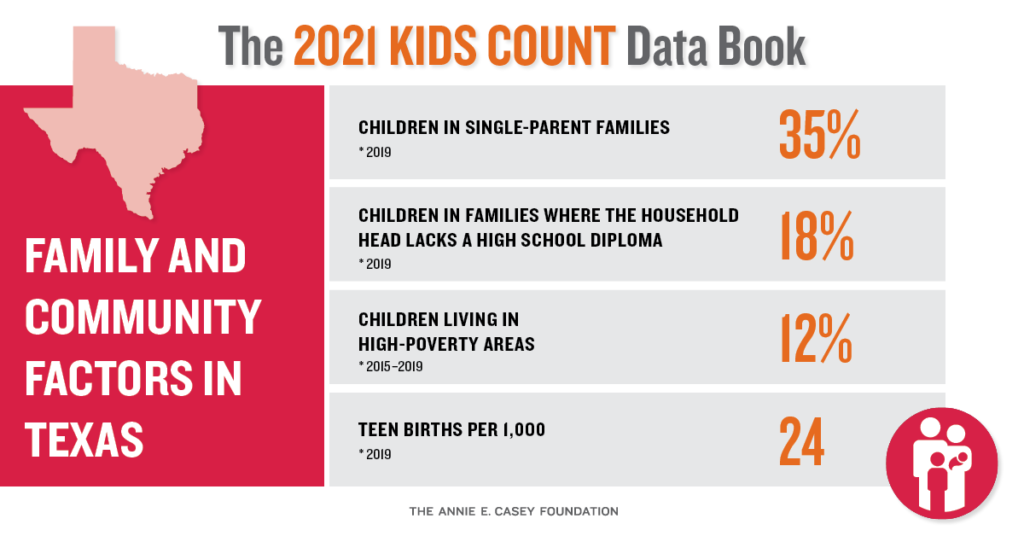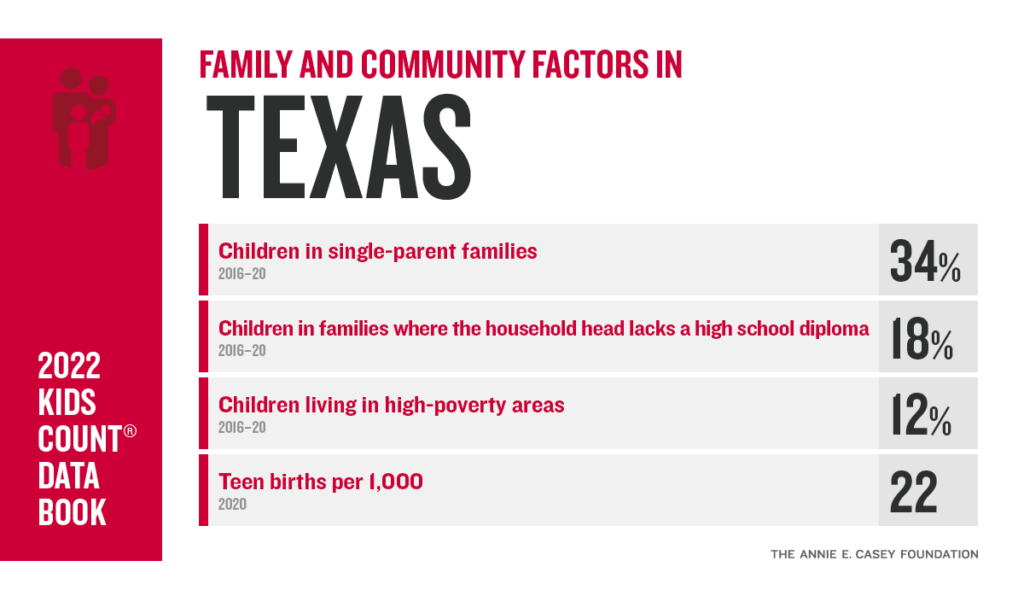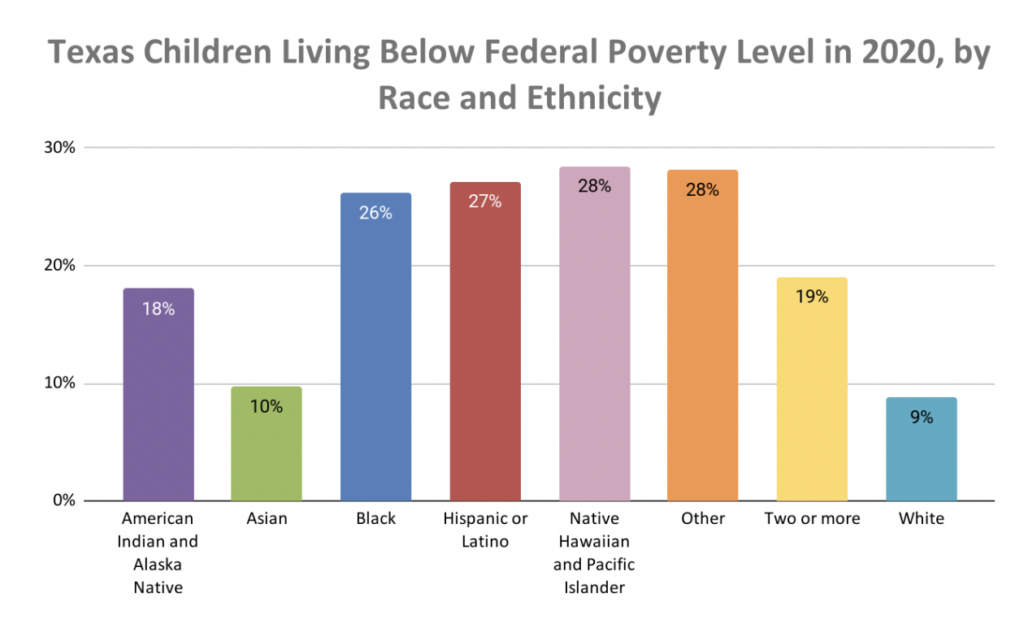As you strive to understand the socio-economic landscape of different regions in the United States, it is essential to examine the prevalent issue of child poverty. In this article, we will focus our attention on one particular state: Texas. By exploring the question “What rank is Texas in child poverty?”, we will shed light on the extent of this pressing concern and gain valuable insights into the challenges faced by its youngest residents. Brace yourself for a revealing exploration that exposes the harsh reality underlying Texas’ child poverty statistics.

This image is property of everytexan.org.
Child Poverty in Texas
Overview of Child Poverty
Child poverty is a pressing issue in Texas, with a significant number of children living in poverty across the state. According to recent statistics, Texas has one of the highest child poverty rates in the United States. This article will explore the impacts, causes, and current rank of child poverty in Texas, as well as examine the factors contributing to this problem and its effects on the well-being and future prospects of children.
Impacts of Child Poverty
Child poverty can have detrimental effects on various aspects of a child’s life. Poverty limits access to basic needs such as nutritious food, healthcare, and education, resulting in poor physical and mental health outcomes. Studies have shown that children living in poverty are more likely to suffer from chronic illnesses, experience developmental delays, and struggle with mental health issues. Furthermore, poverty can hinder academic performance, perpetuating a cycle of disadvantage and limiting future opportunities for upward mobility.
Causes of Child Poverty
Child poverty is a complex issue with multiple causes. Among the primary causes are high rates of unemployment and underemployment, which leave many families struggling to make ends meet. Insufficient wages and income inequality exacerbate the problem, as low-income families often cannot afford basic necessities. The lack of affordable housing in many areas of the state is another significant factor contributing to child poverty in Texas. Racial and ethnic disparities also play a role, as certain minority groups are disproportionately affected by poverty. Additionally, limited access to quality education and healthcare, high rates of teen pregnancies, and the prevalence of single-parent households further contribute to the persistence of child poverty.
National Rankings in Child Poverty
Comparing Child Poverty Rates
When examining child poverty rates across the United States, Texas consistently ranks among the states with the highest levels of child poverty. While poverty exists in every state, the extent and severity of child poverty vary significantly. Texas has consistently been near the top of the list, indicating a pressing need for solutions to address this issue and improve the well-being of its youngest residents.
Factors Influencing Rankings
Several factors influence the rankings of child poverty rates among states. These factors include the overall economic health of a state, employment rates, the prevailing wage levels, availability of affordable housing, and the availability and quality of education and healthcare. The interplay of these factors can lead to significant disparities in child poverty rates, with some states experiencing higher rates due to a combination of economic and social circumstances.
Trends Over Time
Over the past few decades, child poverty rates in Texas have fluctuated, but the overall trend has been one of persistently high rates. Despite efforts to address the issue, poverty remains a pervasive problem, with child poverty rates exceeding the national average. Understanding the trends over time can help policymakers and advocates identify areas for intervention and improvement, and work towards sustainable solutions to alleviate child poverty in Texas.

This image is property of everytexan.org.
Current Rank of Texas in Child Poverty
Latest Statistics and Rankings
According to the latest statistics, Texas ranks among the states with the highest child poverty rates. In recent years, Texas has consistently ranked in the bottom quartile, a position that highlights the urgent need for action to mitigate the effects of child poverty. The high number of children living in poverty puts immense strain on families, communities, and the state as a whole, necessitating comprehensive strategies to address this issue.
Regional Disparities within Texas
Child poverty rates in Texas vary across different regions, with some areas experiencing higher poverty rates than others. Urban areas, especially those with large populations, often face higher child poverty rates due to the higher cost of living and increased competition for resources. Rural areas also struggle with child poverty, as they often lack access to economic opportunities and vital social services. Understanding these regional disparities is crucial for designing targeted approaches to alleviate child poverty in specific communities.
Factors Contributing to Child Poverty in Texas
Unemployment and Underemployment
High rates of unemployment and underemployment directly contribute to child poverty in Texas. When parents are unable to secure stable employment with decent wages, it becomes challenging for them to provide for their children’s basic needs. Additionally, the cyclical nature of poverty can make it difficult for families to break free from its grip, perpetuating the problem across generations.
Low Wages and Income Inequality
Insufficient wages and income inequality exacerbate child poverty in Texas. Many families, despite being employed, struggle to afford basic necessities due to low wages that do not align with the cost of living. Income inequality further compounds the issue, as a disproportionate share of wealth remains concentrated in the hands of a few, leaving many families behind.
Lack of Affordable Housing
The lack of affordable housing in Texas is a significant barrier for families trying to escape poverty. Rising housing costs, particularly in urban areas, consume a significant portion of families’ income, leaving little left for other essential needs. This scarcity of affordable housing forces many families to live in substandard conditions or in neighborhoods with limited access to quality education, healthcare, and other vital resources.
Racial and Ethnic Disparities
Racial and ethnic disparities play a role in the high rates of child poverty in Texas. Certain minority groups, such as Black and Hispanic populations, are disproportionately affected by poverty, facing higher poverty rates compared to their white counterparts. Structural inequities and discriminatory practices perpetuate these disparities, creating barriers to economic opportunity and exacerbating child poverty.
Insufficient Access to Education and Healthcare
Children from low-income families often face limited access to quality education and healthcare, further exacerbating the effects of child poverty. Insufficient funding for schools in disadvantaged areas can result in overcrowded classrooms, inadequate resources, and a lack of support services. Likewise, limited access to affordable healthcare can hinder preventive care and early intervention, negatively impacting children’s overall well-being and development.
Teen Pregnancy Rates
High rates of teen pregnancy contribute to child poverty in Texas. When teenagers become parents, they face significant challenges in completing their education and obtaining stable employment, leading to higher chances of living in poverty. Additionally, young parents often lack the necessary resources and support systems to provide adequately for their children, perpetuating the cycle of poverty.
Family Structure and Single Parenthood
Family structure, particularly single parenthood, is a significant factor contributing to child poverty. Single-parent households, especially those headed by single mothers, face increased financial strain, as they often bear the sole responsibility of providing for their children. Lack of support, both financial and emotional, can make it difficult for single parents to escape poverty and provide a stable environment for their children.
Limited Social Safety Net
The limited social safety net in Texas contributes to the persistence of child poverty. Insufficient access to supportive services such as cash assistance, affordable childcare, and nutritional assistance can make it challenging for families to escape poverty and provide for their children’s needs. Expanding and improving the social safety net is crucial to creating a system that supports families in their efforts to break free from the cycle of poverty.

This image is property of everytexan.org.
Effects of Child Poverty
Health and Well-being
Child poverty has profound effects on the health and well-being of children. Limited access to nutritious food, healthcare, and safe living environments can lead to increased rates of malnutrition, chronic illnesses, and developmental delays. Children in poverty often face higher levels of stress and adversity, which can have long-term negative effects on their mental health and overall well-being.
Academic Performance
Poverty significantly affects a child’s academic performance and educational outcomes. Children from low-income families often have limited access to quality educational resources, including textbooks, tutoring, and extracurricular activities. This lack of resources can hinder their cognitive development, widening the achievement gap between low-income students and their peers. Consequently, children in poverty are more likely to struggle academically, leading to lower high school graduation rates and diminished prospects for higher education.
Long-term Socioeconomic Impacts
The long-term socioeconomic impacts of child poverty are far-reaching. Children who grow up in poverty face numerous barriers to economic mobility and are more likely to experience poverty as adults. The cycle of poverty can persist across generations, perpetuating income inequality and limiting opportunities for upward social mobility. Addressing child poverty is not only a moral imperative but also an essential step towards building a more equitable and prosperous society.
Government Programs and Initiatives
Federal Programs Addressing Child Poverty
The federal government has implemented various programs to address child poverty in the United States. Programs such as the Supplemental Nutrition Assistance Program (SNAP), the Earned Income Tax Credit (EITC), and Medicaid provide crucial support to low-income families, helping to alleviate the effects of poverty on children. These programs aim to provide families with access to nutritional food, financial assistance, and healthcare, reducing the immediate impact of poverty on children’s well-being.
State and Local Initiatives
In addition to federal programs, state and local governments in Texas have launched initiatives to combat child poverty. These initiatives focus on improving access to affordable housing, increasing investments in education, and expanding healthcare coverage. State-funded programs, such as the Texas Department of Housing and Community Affairs’ Affordable Housing Program and the Texas Education Agency’s investments in educational resources, aim to address the unique needs of families and children living in poverty at the local level.
Effectiveness and Limitations of Current Measures
While government programs and initiatives have made significant strides in addressing child poverty, there are still limitations and areas for improvement. The effectiveness of these measures depends on various factors such as funding levels, outreach efforts, coordination among different agencies, and the ability to adapt to changing circumstances. Strengthening the impact of existing programs and addressing their limitations is crucial for ensuring that they reach all eligible families and provide meaningful and sustainable support.

This image is property of everytexan.org.
Efforts to Alleviate Child Poverty
Nonprofit Organizations and Advocacy
Nonprofit organizations play a vital role in combating child poverty in Texas. These organizations provide essential services such as food banks, shelters, healthcare clinics, and educational programs. Additionally, they engage in advocacy work, raising awareness about child poverty issues and pushing for policy changes that address the root causes of poverty. Collaborations between nonprofit organizations and government agencies can enhance the impact of poverty alleviation efforts by leveraging community resources and expertise.
Community-Based Solutions
Community-based solutions are essential for effectively addressing child poverty. These solutions involve engaging communities, including parents, educators, healthcare providers, and local stakeholders, in the development and implementation of anti-poverty initiatives. Community-driven programs can be tailored to meet the specific needs of different regions, ensuring that interventions are culturally competent, inclusive, and sustainable.
Educational and Employment Opportunities
Providing children and families with access to quality education and employment opportunities is crucial for breaking the cycle of poverty. Educational initiatives, such as early childhood education programs and after-school enrichment activities, can narrow the achievement gap and provide disadvantaged children with a strong foundation for future success. Creating job training programs, promoting entrepreneurship, and fostering economic growth can empower families to improve their financial well-being and provide a stable home environment for their children.
Role of Education in Addressing Child Poverty
Early Childhood Education
Early childhood education plays a vital role in addressing child poverty. High-quality preschool programs can enhance cognitive development, improve school readiness, and increase the likelihood of academic success. Accessible and affordable early childhood education programs, combined with parental support and resources, provide children with a strong educational foundation and help narrow the opportunity gap, setting them on a path towards future success.
Quality Public Education
Quality public education is crucial in mitigating the effects of child poverty. Adequately funding public schools, particularly in disadvantaged areas, can provide necessary resources, such as qualified teachers, smaller class sizes, and updated educational materials. Inclusive and equitable educational practices, including targeted interventions for at-risk students and wraparound services, can address the unique challenges faced by children living in poverty and promote educational attainment.
Access to Higher Education
Access to affordable higher education is vital for increasing economic opportunities and breaking the cycle of intergenerational poverty. Expanding financial aid programs, implementing college readiness initiatives, and supporting community colleges and trade schools can make higher education more accessible to low-income students. Encouraging partnerships between educational institutions and local industries can also foster job creation and provide young adults with hands-on learning opportunities to develop marketable skills.
Skills Training and Vocational Education
Skills training and vocational education programs are instrumental in equipping individuals with the skills needed to secure stable, well-paying jobs. By providing specialized training and certifications, these programs can help individuals overcome barriers to employment and increase their earning potential. Collaborations between educational institutions, businesses, and community organizations can ensure that skills training programs align with industry demands, enhancing graduates’ employment prospects and reducing poverty rates.

This image is property of everytexan.org.
Possible Policy Solutions
Increasing Minimum Wage
Raising the minimum wage can help alleviate child poverty by providing families with a more livable income. A higher minimum wage enables parents to better support their children’s basic needs, reducing the strain of poverty. Furthermore, indexing the minimum wage to inflation can ensure that it keeps pace with the rising cost of living and remains an effective tool in combating poverty.
Expanding Social Safety Net
Expanding the social safety net is crucial for reducing child poverty. Increasing access to cash assistance programs, extending the availability and coverage of healthcare programs, and strengthening child and family support services can help lift families out of poverty and provide necessary support for child well-being. Additionally, streamlining eligibility criteria, minimizing administrative barriers, and reducing stigma can encourage families to access and utilize available resources.
Affordable Housing Initiatives
Investing in affordable housing initiatives can have a significant impact on child poverty rates. Increasing the availability of subsidized housing options and implementing rent control measures can help reduce housing costs, making housing more affordable for low-income families. Integrating affordable housing into mixed-income communities and prioritizing the development of supportive housing can create opportunities for families to secure stable housing and access critical resources.
Improving Access to Healthcare
Improving access to healthcare is essential for addressing the health disparities experienced by children living in poverty. Expanding Medicaid in Texas, providing robust funding for community health centers, and implementing targeted healthcare programs that address the unique needs of low-income children can ensure that quality healthcare is accessible and affordable for all. Additionally, investing in preventive care and early intervention can reduce long-term healthcare costs and improve overall child well-being.
Addressing Racial and Ethnic Disparities
Addressing racial and ethnic disparities is crucial for reducing child poverty rates. Policies and initiatives that promote equity and social justice can help dismantle systemic barriers faced by minority communities. This can include equitable allocation of educational resources, targeted economic development programs, and increased representation of diverse voices in decision-making processes. By addressing structural inequalities, Texas can create a more inclusive and equitable society for all children.
Strengthening Education System
Strengthening the education system is vital for addressing child poverty in Texas. Increasing investments in public schools, providing ongoing professional development for teachers, and expanding access to high-quality educational resources and technology can enhance educational opportunities for children from low-income backgrounds. Comprehensive support systems, such as counseling services and mentoring programs, can also promote social-emotional development and address the unique needs of children living in poverty.
Promoting Job Creation and Economic Growth
Promoting job creation and economic growth is essential in addressing child poverty. Policies that facilitate small business development, attract quality job opportunities to underserved regions, and provide incentives for investment in low-income communities can help lift families out of poverty. Collaborations between government, educational institutions, and private industry can foster economic growth and create a thriving labor market, enabling parents to secure stable employment and improve their financial well-being.
Conclusion
Child poverty is a persistent issue in Texas, with adverse consequences for the well-being and future prospects of children. High rates of child poverty in Texas underscore the urgent need for comprehensive solutions to address the underlying causes and mitigate the impacts of poverty on children’s lives. By implementing policy changes, expanding access to education and healthcare, and promoting economic opportunities, Texas can work towards creating a society where all children have an equal chance to thrive and reach their full potential.
